Lessons from the 921 Earthquake
By Chen Wei-Wei (陳芛薇)
Photos by Huang Shi-ze (黃世澤)
Abridged and translated by George Chen (陳纘強)
Lessons from the 921 Earthquake
By Chen Wei-Wei (陳芛薇)
Photos by Huang Shi-ze (黃世澤)
Abridged and translated
by George Chen (陳纘強)
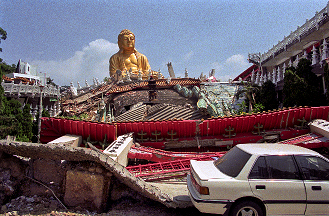
The 921 Earthquake in 1999 not only destroyed residential buildings, but also severely damaged a Buddhist temple in Taichung. (Photo by Lin Yen-huang)
It was early in the morning when I heard an emergency alert on my phone. I was still half-asleep when waves of strong jolts came and shook everything. It was an earthquake. “How strong is the quake? For how long will it shake? Will the building collapse? Should I run out?” In just a short few seconds, I was overwhelmed by fear and helplessness, and thoughts of worry flooded my mind.
The strong 6.0-magnitude earthquake that struck northeastern Taiwan in the morning of August 8, 2019 awoke many from their sleep and brought memories of a catastrophic earthquake that hit the island two decades ago.
At 1:47 a.m. local time on September 21, 1999, three days before the Mid-Autumn Festival, a violent earthquake startled people from their dreams to face nightmares that have arrived so suddenly and unexpectedly. The earthquake lasted more than one minute, releasing energy equal to 46 atomic bombs.
The 7.3-magnitude quake, known as the 921 Earthquake, killed 2,415 people and injured more than 11,000, becoming the worst disaster in Taiwan since the Second World War.
Overnight, landscapes changed, buildings collapsed, bridges broke down, and roads cracked. The railway tracks were deformed and hospitals were packed with dead bodies. Rescue teams from around the world arrived at the disaster zones, racing against time to find and save people trapped under the rubble.
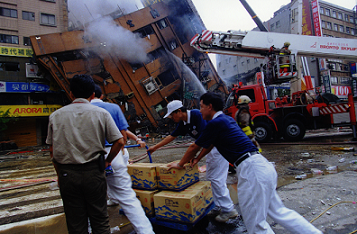
In the wake of the 921 Earthquake in 1999, Tzu Chi volunteers delivered supplies near a collapsed building in Taipei which killed 87 people. More than 50,000 buildings in Taiwan have collapsed as a result of the massive earthquake. (Photo by Lin Feng-qi)
The devastating 921 Earthquake destroyed many families, leaving 134 children orphaned, including Xu Ya-ting (許雅婷) and her younger brother. Back then, Xu was just a junior high school student. On that fateful night after the quake hit, her father and older brother went downstairs to find an exit for the family to escape. Her mother also went downstairs to give a pair of trousers for her father to wear, leaving Xu and her younger brother upstairs. Suddenly, an aftershock hit and the second floor collapsed. Xu and her younger brother survived, but the rest of the family perished. To this day, Xu still harbors the guilt of not stopping her mother to go downstairs. If she had held on to her, her mother would have lived.
The youngest survivor of the 921 Earthquake, only about 10 days old back then, is now 20. As time passed, homes were rebuilt and the landscape was once again transformed by Mother Nature. Nowadays, it has become hard to see the traces left by the disaster. Nevertheless, the mention of “921” still strikes fear and panic for many people in Taiwan.
Over the past 20 years, earthquakes have continued to hit Taiwan. According to Standard & Poor’s, Taiwan is one of the top ten countries most vulnerable to earthquakes.
Fortunately, subsequent earthquakes have been smaller in scale and with fewer casualties. But, has Taiwan truly learned its lessons from the disaster and is adequately prepared to prevent casualties if a massive earthquake strikes again?
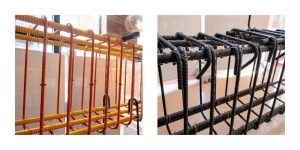
Traditional methods of placing stirrups (left) to hold steel reinforcing bars together have been replaced by stronger and sturdier methods (right).
Regulation and construction issues
The 921 Earthquake left over 51,000 buildings completely collapsed and over 53,000 buildings partially collapsed. Many more buildings were listed as unsafe. Many of these are steel-reinforced concrete buildings that became popular in the 1970s. People and experts wondered, since the buildings used reinforced concrete, why did so many of them collapse?
One of the reasons was the lack of adequate laws and regulations on the earthquake resistance of buildings. For example, the 1999 Seismic Design Specifications and Commentary of Buildings report classified the Chelungpu Fault—which triggered the 921 Earthquake—as Type 2 active fault, a classification which did not regulate the construction of buildings on the fault line to be highly quake resistant.
Another reason was the lack of quality control on construction standards. When the 921 Earthquake struck, although Taipei registered a relatively weaker magnitude of 4.0, four buildings collapsed, resulting in heavy casualties. The geographical condition of Taipei Basin was a factor contributing to a stronger shake, but shoddy construction practices was also the culprit for the tragedy.
“Investigations have revealed that the collapse of buildings during the 921 Earthquake was mainly due to poorly installed concrete reinforcement structures,”commented Hwang Shyh-Jiann (黃世建), Director General of the National Center for Research on Earthquake Engineering (NCREE) and Professor of Civil Engineering at National Taiwan University.
Poor reinforcement practices include insufficient stirrups to hold the steel reinforcing bars (or rebars) together, rebars that are spaced too far apart from one another, or the use of poor-quality materials that result in low-strength concrete, among other issues.
The poor quality of the construction process is closely related to the fact that the safety of buildings was not given top priority at the time. For example, for the structures to be quake resistant, the ties for the stirrups to hold the rebars together should be lapped at 135 degrees instead of the commonly employed 90 degrees. “This standard was already in place before the 921 Earthquake, but it was regarded as inconvenient and labor-intensive, so there was a lot of resistance against following the standard,” Hwang said.
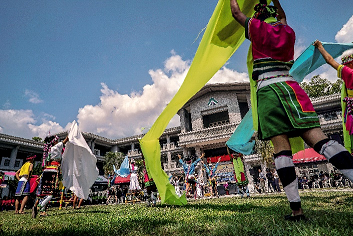
After rebuilding more than 50 schools damaged in the 921 Earthquake, Tzu Chi Foundation has started a project in 2014 to help 26 schools become earthquake-resistant. (Photo by Yang Shun-bin)
Chen Yi-ming (陳依民), section chief of the 921 Earthquake Museum of Taiwan, talked about the culture and way of thinking in the construction field of the early days. “In the past, those that came before us told us to build houses without the need for attention to details or safety. Rebars would be easily assembled without proper professional guidance or supervision. Many structures built in the past do not meet today's standards, but this is how many houses and buildings were constructed in the early days.”
After the severe casualties in the 921 Earthquake, many have called for an overhaul of building regulations and construction practices. In terms of earthquake zones, the government reclassified the zones with updated data and incorporated more houses within strong quake zones. New regulations on the construction of buildings were also created, including quality control, earthquake resistance assessment, and structure reinforcement measures.
After the 921 Earthquake, the construction quality of public buildings has significantly improved. The private sector and NGOs have also put more attention on the quality of construction processes. For example, after the disastrous earthquake, Tzu Chi Foundation took over the reconstruction of more than 50 schools, using the highest quality of steel reinforced concrete and following standards for the construction of tall buildings. The entire process was recorded and there was professional onsite supervision.
The Building Safety Certification Association, founded five years ago by structural engineer Dai Yun-fa (戴雲發), has been promoting safety certification of buildings, which incorporates systemized methods for steel reinforcement, employment of professional consultants on structural safety, and onsite supervision on the quality of each construction process, etc.
After witnessing the tragic collapse of buildings in the 921 Earthquake, more and more people working in construction sites have also become willing to adopt labor-intensive safety measures in the construction process.
Reinforcement measures for vulnerable buildings
After the 921 Earthquake, in addition to buildings that have completely or partially collapsed, there were large numbers of buildings that were identified to have structural vulnerability. As it was impossible to demolish and rebuild all buildings, the government initiated a structural reinforcement plan for vulnerable buildings to strengthen their resistance to earthquakes.
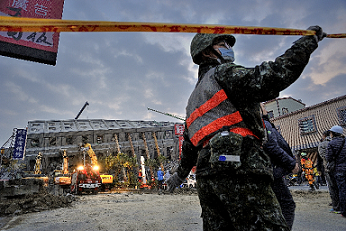
On February 6, 2016, a building complex in Tainan collapsed following an earthquake, killing more than a hundred people. (Photo by Huang Xiao-zhe)
Hwang said that reinforced concrete buildings—including public and private ones—built before the 921 Earthquake accounted for 59% of the floor space of all existing buildings in Taiwan. These buildings were listed as the most urgent cases for assessment to determine whether reinforcement was necessary.
Public buildings included schools, police stations, fire stations and township offices, and the reinforcement plan was most thoroughly implemented in school buildings. Since 2009, the Ministry of Education started to promote earthquake resistance assessments and reinforcement plans for school buildings across the nation, with the first phase expected to be 100% completed by the end of 2019.
The importance of earthquake-resistant reinforcement became evident during the Kaohsiung earthquake in 2010. After the quake, the building pillars of a school that did not go through reinforcement were visibly damaged with rebars exposed, while the building structure of another school located only 1.2 kilometers away and that underwent reinforcement showed no trace of damage.
Of the other public buildings, around 60% to 70% have reported to have completed assessment and reinforcement, but this number may be optimistic since the assessments were self-reported.
Compared to public buildings, a much larger number of private buildings were considered vulnerable. According to a quick screening across Taiwan's buildings in 2017 and 2018, about 72% of buildings taller than 12 stories and about 61% of buildings between nine to eleven stories may be structurally vulnerable.
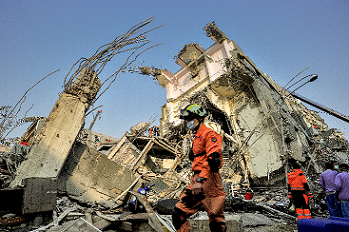
The Weiguan building in Tainan toppled during a 6.4-magnitude earthquake that hit Kaohsiung in 2016. Disasters caused by earthquakes have continued to occur in Taiwan over the past 20 years. (Photo by Huang Xiao-zhe)
Situated at the convergence of the Eurasian Plate and the Philippine Plate, Taiwan is geologically active with 33 active faults and potentially hidden faults throughout the island. As many as 8.6 million people live within 10 kilometers of these active faults.
On February 6, 2016, a 6.4-magnitude earthquake hit Kaohsiung, causing a 17-story building to topple and collapse. Exactly two years later in 2018, an earthquake in Hualien resulted in the collapse of four buildings. Once again, people in Taiwan were reminded of the high risks and dangers of their living environment.
With the public's increasing awareness for earthquake safety, Taiwan's government launched a plan to assist the public with costs for assessing their building's structural vulnerability. But as well intentioned as the plan was, it was not practical because many simply could not afford reinforcement—which usually costs at least NT$1 million (or US$32,274). And for those who could afford it, they were likely to be concerned about the drop in their real estate value if the assessment showed safety concerns.
With the unsuccessful first plan, the government launched another plan, requiring private buildings that could impact public security, such as cinemas and department stores, to be assessed for structural vulnerability. The government also reinforced some residential buildings to serve as models to encourage private buildings to go through reinforcement and minimize damages.
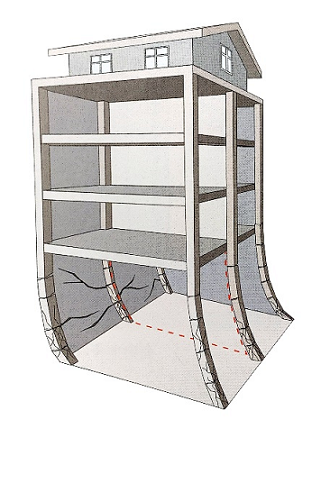
Inadequate design and improper reconstructions, such as insufficient columns and support on the ground floor, the removal of original walls, or illegal additions on the top floor, result in a building's structural vulnerability. (Picture provided by the National Center for Research on Earthquake Engineering)
Despite numerous plans to improve the earthquake resistance of buildings, people continue to wonder whether new buildings built after the 921 Earthquake are actually safer. Hwang's answer is positive, but he also added that "there is still probability, albeit lower, of collapsed buildings due to an earthquake," since many buildings less than seven stories high were not professionally supervised during construction and buildings less than five stories tall may not even have been adequately designed from the beginning.
In terms of earthquake resistance, the vast majority of private buildings still has potential risks and dangers. Unlike Japan and the United States, Taiwan does not have an authorized institution governing the earthquake resistance and safety of buildings. There is also a lack of a comprehensive system for construction supervision as well as adequate compensation and professional training for construction workers. All these factors contribute to the safety issues of buildings.
Lack of awareness in disaster prevention
Though the reinforcement of buildings to make them quake-resistant has significantly reduced the probability of building collapses, there are still reports of deaths in an earthquake, often killed by falling objects and furniture.
Professor of Civil Engineering at National Chiao Tung University Shan Hsin-yu (單信瑜), who has been promoting disaster prevention education, stated that about one-third of the deaths in the 921 Earthquake resulted from traumatic brain injuries and skull fractures. From his observation and research of more than a decade, Shan concludes that many casualties happen because the public lack knowledge on disaster prevention, which is the result of a general disregard on disaster prevention education. "We teach people on the reasons why earthquakes happen, but we don’t teach them about the impact, damages, and casualties that earthquakes bring to Nature and humanity. As a result, the public are not afraid when earthquakes strike."
"School staff members often tell me that their building columns are large and safe, or that their school was fine during the 921 Earthquake." Shan often visits schools to talk about disaster prevention, hoping to educate people on how to protect themselves in the event of a disaster. However, few teachers attend his classes.
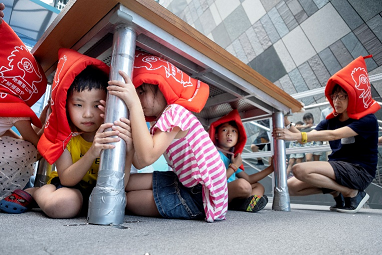
"Drop, cover, hold on" are earthquake safety tips to help reduce injuries from fallen objects during an earthquake.
If disaster prevention drills are carried out correctly and adequately, teachers and students will know how to evacuate in different situations to stay alive. But, the reality in Taiwan is that disaster prevention is not emphasized, as drills are conducted by each school without professional guidance and supervision.
Pan Chang-Chih (潘昌志), associate editor of a blog dedicated to promoting knowledge on earthquakes for the general public, said that he had witnessed a teacher instructing students to leave their protective headgears in the cabinet at the back of the classroom and telling them to take them out only during earthquake drills. Shan also said that the 6.1-magnitude earthquake that struck on April 2019 occurred during students’ nap time, but teachers did not wake them up when the quake hit.
Disaster prevention should have been most thoroughly implemented in schools, but the overall lax approach to it reflects the general lack of awareness in disaster prevention in Taiwan's society. Simple measures such as securing furniture to walls, or the "drop, cover, hold on" tips for when a quake strikes are easy to do and remember, but in reality, few people practice them.
Shan said that teachers who have taken disaster prevention classes pay more attention to implementing safety measures, and some have taken the initiative to secure large facilities such as water dispensers and cabinets to walls. Teachers’ learning and participation in disaster prevention is critical to imparting knowledge and practices in disaster preparedness.
In addition to education, the approach and attitudes of the government toward disaster prevention also affects the public's awareness. For example, the Japanese government informs the public about the potential risks, damages, and estimated casualties if an earthquake or tsunami strikes. But the government of Taiwan does not disclose this kind of information. Taiwan Association of Disaster Prevention Industry's secretary general Huang Shao-Wei (黃少薇) said, "Every time an earthquake strikes, the government describes the event as a normal release of energy from the earth in an attempt to prevent panic, but this approach really decreases the public's awareness of potential risks and dangers."

Disaster preparedness includes securing furniture at home, storing dry foods and daily necessities in a designated location, and preparing an emergency bag with food, tools, money, ID copies, and a first aid kit to be brought along during an escape or when seeking shelter.
Pan also suggested that the government should inform the public with correct and accurate information so people can take precautions at all times. The 2009 L'Aquila earthquake in Italy is a case in point. After small ongoing tremors in the ancient city of L'Aquila, government officials communicated to the public that there is no danger, hoping to calm people's fears. However, only days after, a 6.3-magnitude earthquake eventually struck, killing more than 300 people.
Chen Kuo-chang (陳國昌), Director of the Seismic Information Center at the Central Weather Bureau, said that the energy release of earthquakes cannot be classified as normal or not. The Weather Bureau has stopped reporting such classifications, instead informing the public on the current situation of the earthquake, forecast for aftershocks, and other information.
The government can communicate risks to the general public by using opportunities during earthquakes to inform about active fault zones and structurally unsafe buildings. This way, the general public can have more awareness and may make more informed choices about choosing where to live.
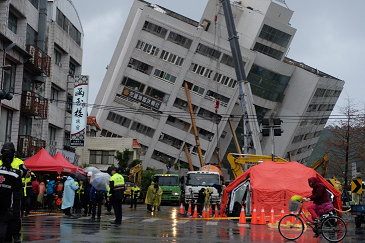
In 2018, the Yunmen Cuidi building tilted and collapsed after a 6.4-magnitude earthquake struck Hualien. (Photo by Hsiao Yiu-hwa)
The renowned seismologist Ma Kuo-Fong (馬國鳳) and her Taiwan Earthquake Model team have published a map of Taiwan in 2015 with an estimated probability for earthquakes to strike in the next 50 years. The Milun Fault was estimated to have a 42% chance of a 6.4-magnitude earthquake, coinciding with the magnitude of the Hualien earthquake in 2018. The team also predicted that there was as much as a 55% chance of a 7.0-magnitude earthquake to hit Taiwan in the next 50 years. The map hopes to inform the public about the potential risks and dangers so they can take action to prepare and prevent disasters.
Chen said that there is still so much unknown in the field of seismology and that practical applications of the science in daily life is still remote. He thinks that instead of waiting for discoveries and advances in earthquake prediction, it will be faster to lower disaster risks by developing earthquake-resistant designs that can be popularized.
Keeping up with anti-seismic technology
Even today, earthquakes still cannot be predicted, but an earthquake warning system based on the characteristics of seismic waves has increased the public's survival rate. Since five years ago, more and more people in Taiwan have received earthquake alert notices in their mobile phones before an earthquake struck.
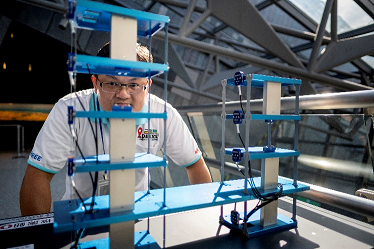
A simulation experiment with shear walls (in white)—vertical structures that resist lateral seismic forces—shows that if shear walls are removed, the entire building will sway severely when an earthquake strikes.
When the warning system detects a P wave, which travels faster than other seismic waves, the system immediately sends an alert notice so people can prepare before the more harmful S wave arrives.
The Central Weather Bureau in Taiwan has adopted a regional earthquake warning system, which is highly accurate but relatively slow. For example, if an earthquake strikes Hualien, people living 100 kilometers away in Taipei can receive an alert notice about 12 or 13 seconds before the quake hits Taipei. However, areas within 55 kilometers from the epicenter are blind zones that cannot receive any warnings before the waves arrive.
When the 921 Earthquake hit, the Central Weather Bureau completed the forecast report in 102 seconds after the quake struck. Now, 20 years later, the time to complete a forecast has progressed to 15 seconds. With faster forecasting time, earthquake warning systems can issue alerts earlier. More advances are still to come, as in 2020, the forecasting time is expected to be shortened to ten seconds and the blind zones will reduce to areas within 35 kilometers from the epicenter.
Another local earthquake warning system adopted by the non-government sector is less accurate but is faster and has a smaller blind zone, which is helpful for people living in the zone. A research fellow at the NCREE, Lin Pei-yang (林沛暘) and his team have been using this local warning system, which can issue warning alerts 15 seconds before an earthquake 100 kilometers away arrives. Within the 30-kilometer blind zone, alerts can also be received 5 seconds before the quake hits.
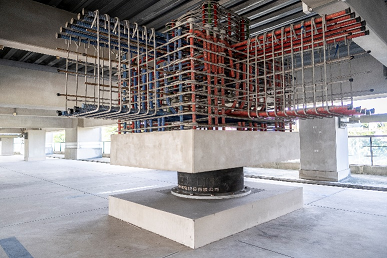
The application of lead rubber bearing—a seismic isolation device made of rubber with a lead core—can significantly reduce the impact of an earthquake on a building.
The critical few seconds that experts have worked hard to gain are crucial for the public to respond. The earthquake warning system has been widely adopted for different applications. More than 3,000 schools in Taiwan have used the warning system so teachers and students can take necessary precautionary measures. High speed trains can brake and stop in advance to prevent derailment. Doctors can discontinue surgery, police dispatch centers can prepare for disaster relief, and high-tech factories can automatically suspend all machinery to reduce losses and damages.
However, despite notice alerts, the time left to respond is very limited. When an earthquake is about to come, should one first seek shelter, turn off the gas, or open the door? Imagine a system that automates all these steps and also turns on emergency lighting to facilitate escape and evacuation. This automation system is what Lin and his team are working hard to develop.
Lin said that earthquake-resistant building materials are currently available in the market, but due to their high costs, few buildings have used them for construction. If it's not possible to rebuild or reinforce an entire building to make it earthquake-resistant, an alternative is to implement reinforcement in stages. For example, the bathroom or bedroom space may first be reinforced to provide a safe space to take refuge when a quake occurs.
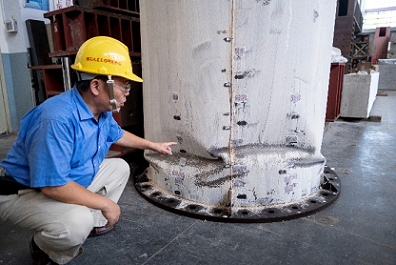
Hwang Shyh-Jiann, Director General of the National Center for Research on Earthquake Engineering, said that pressure tests show how force is transmitted on a reduced scale model and offer implications for construction methods of earthquake-resistant structures.
The most fundamental way to prevent disasters during an earthquake is to rebuild or reinforce the structure of buildings. However, if this is not a feasible option, one can consider purchasing an earthquake-resistant wardrobe or table to take refuge when an earthquake strikes. A monitoring system for a building's structural safety can also be installed, as it will automatically create an assessment report after an earthquake hits to help determine whether a building is still safe or not.
Despite the advancement of technology and the development of earthquake-resistant devices, the availability and accessibility of them for the general public is still central for disaster prevention to be effective. So, it is of key importance that manufacturers are willing to mass produce earthquake-resistant devices to make them affordable to everyone.
Developing a disaster prevention industry
"Have you ever heard of dry shampoo and portable toilets? In Taiwan, you can only find these items in postpartum care centers or mountaineering gear shops. In Japan, however, they are sold as items for disaster prevention," said Huang from the Taiwan Association of Disaster Prevention Industry.
In Japan, small items for disaster prevention include gloves and whistles, and large products include refuge shelters. Taiwan is capable of producing such products, but there is currently a lack of a disaster prevention industry. In Taiwan, the NCREE has developed an earthquake-resistant table that can withstand the force of 150 tons (equivalent to the force of 66 elephants), but no manufacturer is yet willing to mass produce this table.
The delivery of emergency alerts also has room for improvement. Although the Central Weather Bureau issues alert notices when an earthquake reaches a certain scale, not everyone receives the notice. Lin expressed that a market mechanism can be developed to allow government-issued disaster alerts and information to be sold to telecom operators and security service companies. These private companies can in turn develop value-added services for customers to purchase as needed. This way, progress and improvement of related technology can be accelerated. Pan also said that the disaster prevention industry in Japan offers consumers with different products and services to buy according to their needs and purchasing power.
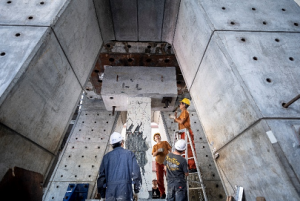
The National Center for Research on Earthquake Engineering conducts all kinds of small and large experiments.
The frequency of earthquakes in Taiwan has led to a significant development of academic research in seismology and advanced technologies in earthquake resistance that often serve as models for the international community. However, the public's awareness of disaster prevention and the availability of related products in the market remain disconcertingly low.
Rebuilding and renewal after disasters
The two earthquakes that hit Kaohsiung in 2016 and Hualien in 2018 resulted in dozens of people killed. They also brought back nightmarish memories of the 921 Earthquake in 1999. Many experts have been focusing on how to reduce disaster caused by earthquakes, with geoscientists delving further into the study of earthquakes and civil engineers looking into earthquake-resistant designs and structures. The NCREE has a variety of equipment for earthquake simulations and all kinds of experiments to develop earthquake-resistant construction methods and technology.
Hwang, who has focused on applications of research in earthquake resistance following the 921 Earthquake, said that in the past, “people in the field of civil engineering didn't feel that their studies were closely related to spaces that people lived in. After the 921 Earthquake, however, we've all deeply realized the close relationship between buildings and people's lives.”
Shan, who is committed to disaster prevention education, shared that he was born in 1964, the year a massive earthquake struck Tainan. In the next 30 years, there were no major earthquakes that hit Taiwan. So, like many other people in Taiwan, Shan didn't have any experience with major earthquakes before the 921 Earthquake. “I had no idea of what a major earthquake was like because I've never experienced one before.” Having surveyed the disaster and witnessed the tragic devastation of the 921 Earthquake was one reason that led Shan to focus on disaster prevention education.
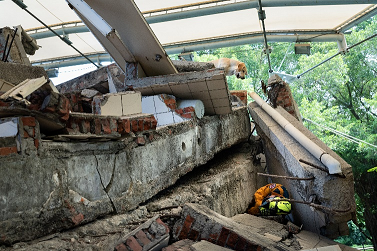
A rescue dog team from the Fire Bureau of Taichung City holds a training at the 921 Earthquake Museum of Taiwan. (Photo by Xie Pei-ying)
Elementary and junior high school students tour the 921 Earthquake Museum of Taiwan on their field trip, laughing and playing around the buildings that were destroyed by the massive quake. These students are part of a generation who has not experienced a major earthquake. Do they know the potential terrors of an earthquake? Will the 921 Earthquake be eventually forgotten, like many other earthquakes in the past?
The movement of tectonic plates not only formed the island of Taiwan, but also brought catastrophic earthquakes throughout the island's history. For the people of Taiwan, earthquakes are part of life. Living on the earthquake-prone island, it is important for people to face the real risks and potential dangers of earthquakes, remember the tragedies from the past, and reflect on the lessons brought by those who have lost their lives to the disasters. Before the people of Taiwan can become better prepared to live in peace with earthquakes, there is still a long way to go.
Contact Us | Plan a Visit | Donate
8 Lide Road, Beitou 11259, Taipei, Taiwan
886-2-2898-9999
005741@daaitv.com
©Tzu Chi Culture and Communication Foundation
All rights reserved.
